M. Isidora Forrest's Blog, page 48
October 5, 2013
The Key to Egyptian Magic, Part II
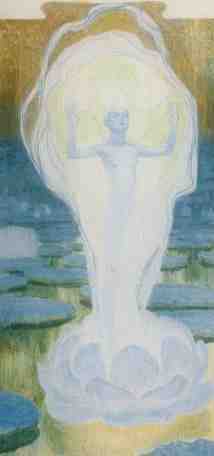
Art seems to capture Kheperu best; this is The Lotus Soul by Frantisek Kupka, 1898. This is what the energy feels like in Kheperu
Last week, we talked about Kheperu or Transformations as the key to Egyptian magic. This is the technique by which a human magician may briefly partake of Divine powers through the use of sacred imaginal images, ritual speech, and right action. It is a way of empowering our magic.
To develop this technique, a society would need to understand that human beings could become godlike—which ancient Egypt did—and further, that human and Divine beings naturally interact with each other and mutually affect each other.
This is a magical and participatory world. In Jeremy Naydler’s book The Temple of the Cosmos, he comments that the Egyptians believed human beings depended on the Deities, but that the Deities also depended on human beings—even to the extent of relying on human action to help mobilize heka (“magic”) in the universe through the temple rites. Both Deities and humanity must uphold Ma’et or the universe will be thrown into chaos. Thus human beings have an innate power and influence, although they cannot hope to match that of the Goddesses and Gods. In this world view, it was theoretically possible for a human being—especially one who had acquired a lot of heka—to cause chaos in the universe. If humans are part of the cosmic order, they can affect the cosmic order. (If you don’t think that’s true, you’ve been among the fortunate few who haven’t been listening to the news.)
This interconnectedness is why we sometimes find threats made against the Deities in Egyptian magical formulæ. This was one of the things that freaked out Greek magic workers when they encountered it. To them, claiming godlike power was hubris—and the Gods were sure to smack you down for it rather than help you out.

Heaven and Earth
Yet the idea that human beings have the power to affect the universe stems from the interrelatedness and interdependence of the human and the Divine worlds in Egyptian tradition. In the same way that the Great Goddess of Magic, Isis, threatens to stop the Boat of the Sun in its tracks unless Her son Horus is healed, so the human magician sometimes threatened the Deities with a similar upset to the cosmic order unless her desires were met. “The expertise of the magician lay in bringing together the spiritual and material levels in a deliberately engendered and powerful coalescence. Magic did not function exclusively on the physical or the psychic or the spiritual planes but on all three together,” writes Naydler. And a most effective way of joining all three worlds is through the technique of Kheperu.
Some Examples of Kheperu
[image error]
“I put on the cloak of the Great Lady, and I AM the Great Lady.”
In his excellent study, Conceptions of God in Ancient Egypt, the One and the Many, Egyptologist Erik Hornung defines Egyptian Deities by three criteria: Onoma (the name of the Deity), Logos (words or knowledge about the Deity), and Eidolon (the image of the Deity). All three, combined with ritual, are also used in Kheperu as we see it expressed in Egyptian texts. A longish passage from the Coffin Texts illustrates these principles and highlights some of the characteristics of Kheperu.
“The Sistrum-Player is in my body, the pure flesh of my mother, and the dress will enclose me. I don the dress of Hathor, my hands are under it to the width of the sky, my fingers are under it as living uraei, my nails are under it as the Two Ladies of Dep, and I kiss the earth, I worship my mistress, for I have seen her beauty. She creates the fair movements which I make when the Protector of the Land comes; the gods come to me bowing and praise is given to me by the gods, they see me at my duty, and I am initiated into what I did not know, I cross the retinue of this Great Lady to the western horizon of the sky, I speak in the Tribunal. [...]
“The god who protects the land comes,” say the horizon dwellers concerning me. “The god comes, having gone aboard the bark,” say they who are about the shrine, who sit in the sides of the bark, who eat their food. They see me as the Sole One with the secret seal. I don the dress, I wear the robe, I receive the wand, I adorn the Great Lady in her dignity. Her Sistrum-Player is on her lap, and he has built mansions among your great ones, he has presented offering cakes, so that he may live thereon and that he may celebrate the monthly festival in his hour in company of those who are in linen, for he has looked at his face. So says the occupant of the throne of the Great Lady concerning me.”

God-blasted; beautiful art by Andrew Gonzales; you can buy prints, yay!
We can be sure that the deceased is intended to be in the Kheper of Form of the Goddess because when he “dons the dress of Hathor,” “the Sistrum-Player is in my body,” it is She Who “creates the fair movements which I make,” and the horizon dwellers “see me as the Sole One with the secret seal.” He employs the Onoma, the names and epithets, of Hathor in his formula. He has knowledge of Her Logos for he describes Her place in the sacred barques of the Gods. He also uses Her Eidolon, symbolized as the dress of Hathor, building up the Goddess’ image through the description in the text and donning Her dress or image.
As in this example, Kheperu is often characterized by a multiple consciousness. Here, the deceased perceives as himself, as Hathor, and as Her son, the Sistrum-Player. He is the Great Lady, he is Her son, and he is Her worshipper. He is both human being and Divine Being. He mediates between Heaven and Earth, partaking of and blending both.
Another excellent example is a Coffin Text formula “for the Soul of Shu and for Becoming Shu”:
“I am the soul of Shu the self-created god, I have come into being from the flesh of the self-created god. I am the soul of Shu, the god invisible of shape, I have come into being from the flesh of the self-created god, I am merged in the god, I have become he.”
In the rest of this spell, the magician spends considerable time making statements that identify her with Shu. She tells the full myth of Shu, and beautifully ends the formula with “I am invisible of shape, I am merged in the Sunshine-God.”
In this example, the deceased is identified with Re, quality by quality—which would allow ritual time for visualization:
“His sun disk is your sun disk;
His rays are your rays;
His crown is your crown;
His greatness is your greatness;
His appearings are your appearings;
His beauty is your beauty. . .”
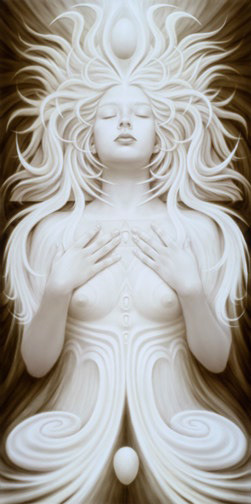
And another Gonzales, because, damn beautiful
In the Book of Coming Forth by Day, the deceased says:
“Horus has invested me with his shape [. . .] I am the falcon who dwells in the sunshine, who has power through his light and his flashing. My arms are those of a divine falcon, I am one who has acquired the position of his lord, and Horus has invested me with his shape. “
Once the Kheper is assumed, the Deity could be perceived within: “Hail to you, Khopri within my body” states a Coffin Texts formula.
I have no doubt that if you worked these spells today—as written and while in the proper frame of mind—you could indeed assume the Form of Hathor or Shu or Re or Horus…or Isis.
This is really a huge topic and, once again, I have taken up enough of your time. One of the most important things about this technique is that it persisted. From ancient Egypt to the magic of the Greco-Egyptian Magical Papyri to the Hermetica to early Christian magic to Medieval magic to Qabalah and Christian mystics to modern magic, Kheperu is there. And it is there because it works.
Filed under: Goddess Isis, Modern Paganism Tagged: Ancient Egypt, Assumption of Godform, Deities, Deity, Egypt, Egyptian magic, Goddess Isis, Hathor, Isis, Isis Magic, Isis the Magician, The key to Egyptian magic








September 28, 2013
The Key to Egyptian Magic, Part 1
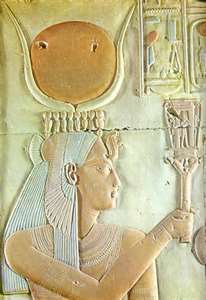
“I am Isis”
Yep. I’ve said it. Balls out. If I had balls. So ovaries out, I guess. I’m certain that the technique I’m going to talk about today is one of—if not the—key to Egyptian magic. It has no known Egyptian name, but you find it everywhere throughout Egyptian sacred written materials. It freaked out the Greeks when they learned about it from Egypt. It still freaks out some modern magic workers.
Here, let me demonstrate it:
I am Isis. I have gone forth from my house and my boat is at the mooring rope… O you who travel in the sky, I will row him with you, I will travel as Isis.
My name is Isis in the Sealed Place; I am in my name and my name is a god; I will not forget it, this name of mine.
I am Isis when she was in Chemmis, and I will listen like him who was deaf and who stared.
Go behind me for I am Isis!
Do you see? These excerpts from the Coffin Text show the technique precisely. Here’s another example of the technique I wrote for a Wiccan publication:
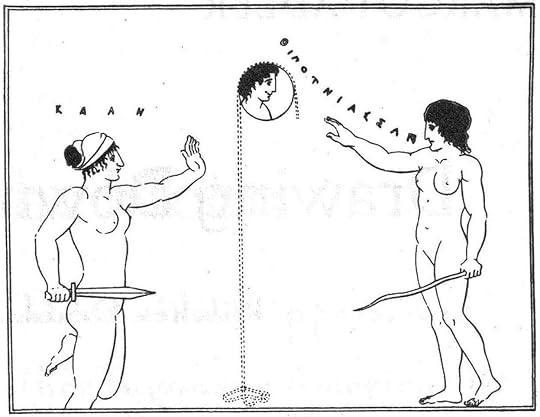
Thessalian witches Drawing Down the Moon
Cool moonlight streams into the Circle, falls upon the altar, glitters the silver jewelry upon the breast of the High Priestess. Her eyes are closed. Her arms and legs are flung wide—as if she would abandon her body by sheer human desire. She feels her heart radically alive. She breathes softly and deeply, praying in silence for the Goddess to come, to come.
Before her, the High Priest kneels, “I invoke Thee and call Thee, Mighty Mother of us all, By seed and root, by bud and stem, by leaf and flower and fruit, by life and love do I invoke Thee to descend upon this Thy servant and Priestess!”
The witches begin a low humming as the High Priest continues to invoke the Moon Goddess by Her many names, asking Her, praying Her to descend—now! now!—into the body of Her Priestess
Then a sharp intake of breath. The High Priestess’ breathing has become ragged. Moonlight catches in her hair, illuminates her body. An electric thrill runs up her spine. The nape of her neck prickles with spirit fire. Her hair stands on end. Her dark eyes snap open, staring strangely. The atmosphere within the Circle is changed. Every one of us feels it. Excitement in the pit of the stomach. Anticipation. Truth.
The High Priestess looks into our eyes, into our hearts, and begins to speak the Charge of the Goddess, “Whenever you have need of anything, once in the month, and better it be when the moon is full, then shall you assemble in some secret place to adore the spirit of Me, Who am Queen of all the Witches…”
We have “Drawn Down the Moon.” The woman who was our High Priestess is—for this brief and sacred moment—the Goddess incarnate. And She gives us Her blessings.
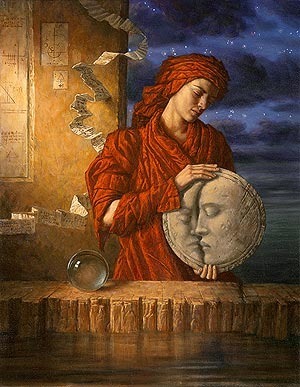
A beautiful modern rendition of Drawing Down the Moon by Jake Baddeley. You can purchase a copy here.
The modern Wiccan practice of Drawing Down the Moon comes to us from ancient Greece, when it was a common power practice of the famous Thessalian witches. The technique was known in even the highest intellectual circles of Greek and Roman society. Plato mentions it as do Lucan and Horace.
Now, the Thessalian witches could have developed the technique themselves, but more than likely, it came to them from that ancient and seemingly eternal font of All Things Magical, Egypt.
As I said, we don’t have an Egyptian name for it. I have called it Kheperu, ”Transformations” or “Forms” (in Isis Magic & Offering to Isis). The Egyptian root of the word means “to be, to exist, to form, to create, to bring into being, to take the form of someone or something, and to transform oneself.”
Recognizing Kheperu
It’s relatively easy to tell when we are witnessing the technique of Kheperu. Most simply, whenever we find the deceased, the priestess, or the magician claim TO BE a particular Goddess or God and speaks in the first person, we are likely to be witnessing Kheperu. It is the voluntary taking on of the astral or imaginal form of a Deity that enables the ritualist to share, albeit briefly, in the powers and Divine energy of that Deity, usually for the purpose of enhancing the effectiveness of a ritual or for deep communion with that Deity.
A clear example comes from a Coffin Text about the Goddess Hathor. The deceased says:
I am in the retinue of Hathor, the most august of the Gods, and She gives me power over my foes who are in the Island of Fire. I have put on the cloak of the Great Lady, and I am the Great Lady. I am not inert, I am not destroyed, and nothing evil will come to pass against me.
The deceased “puts on the cloak” of Hathor and becomes Hathor. Doing so enables him to use Her power to protect himself in the Land of the Dead.
The Egyptian Concept Behind Kheperu
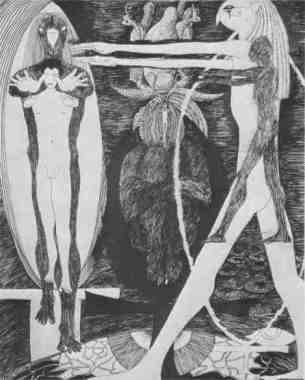
An artistic representation of Kheperu by Steffi Grant; more on this in the next post
There is a basic idea that must exist in a culture to make it possible for the idea of Kheperu to develop—and that is that human beings are not divorced from the Divine and that they have the ability to become even closer to the Divine.
And indeed, the idea that a human being could be god-like is found throughout Egyptian literature. In the Instruction for Merikare, wisdom literature from the First Intermediate Period, it is said that the deceased is “like a god” in the beyond and refers to humanity as the “likeness of God.” A human being with great knowledge is also said to be a likeness of God.
Deities are inherently godlike, but human beings who wish to partake of godlike powers have to make an extra effort—through ritual actions and by being in accordance with Ma’et, “Rightness” or “Truth.” By proper words, deeds, and personal rightness, human beings may participate with the Divine.
Using Kheperu
The technique of Kheperu is a defining characteristic of Egyptian and Egyptian-derived magic. There are reasons to believe that it was more than a mere invocatory convention to the Egyptians and that a genuine connection with the Deity invoked was both intended and achieved. Kheperu was one of the key ways the ancient Egyptians empowered their spirituality—and it is one of the most important ways we can empower our own spirituality and our relationship with Isis, today.
This post is plenty long for today. So this will be a multi-post topic. Next time, we’ll look at some more background on the technique, then we’ll follow that up with some ways we can use it in our relationship with Isis.
Oh yes…one of my Isiopolis posts has been shared on a new blog and forum for polytheists. This from the moderator:
The site includes:
* A blog with reprints of articles from around the polytheist community
* A moderated and drama free FORUM where polytheists can come and share ideas, discuss theology, plan events, share poetry and devotional writing, request help or prayers, barter or sell relevant art/craft/services, make connections, raise funds, and so on.
I love the idea of highlighting great writing that’s coming from the broader polytheist community, but I really hope the discussion forum will become the heart of the site and be a place that’s productive, focused, and really works in service to polytheists from all pantheons.
Check it out and see what you think 
Filed under: Goddess Isis Tagged: Drawing Down the Moon, Egyptian magic, Goddess Isis, Isis, Isis & Hathor, Isis Magic, Isis Rituals, Kheperu, magic and theurgy, Thessalian witch, Wicca








September 21, 2013
An Isiopolis tale

A reconstruction of the Isis temple complex at Isiopolis
As you may know if you’ve read the About Isiopolis tab on this blog, Isiopolis is the Greek name of the ancient Egyptian city in which the greatest Lower Egyptian temple of the Goddess Isis once stood. It means simply, City of Isis. Ancient Roman visitors called the temple there the Iseum (from Greek, Iseion), meaning the Sanctuary of Isis. Pliny, in his book Naturalis Historia, also took note of the Egyptian Delta’s City of Isis—in Latin, Isidis Oppidum.
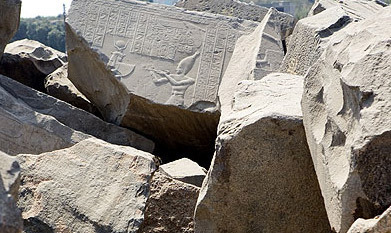
The jumble of stone blocks that is, today, Isiopolis
The modern Egyptian town is Behbeit el-Hagar in Arabic and comes from the ancient Egyptian Per-Hebitet, meaning the House (per means “house” or “temple”) of the Festive Goddess, an epithet of Isis. In Egyptian, the hebit part of the name may refer to a special festival pavilion used during the Isiac rites there. In Arabic, “Per-Hebitet” became Behbeit and “el-Hagar” means “of the stone blocks,” which makes sense given the state of the site. A papyrus from the Third Intermediate Period also calls Isiopolis “the place where offerings are set down.”
I recently came across a legend about Isis and a neighboring temple that I hadn’t heard before. We only have part of it, but here’s what we have:
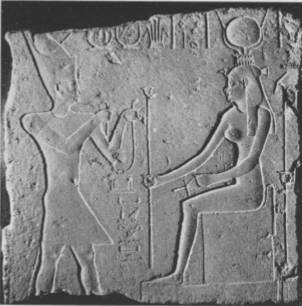
Ptolemy offering to Isis; from the Temple at Isiopolis
Pharaoh Nektanebos, a king of the 30th dynasty and a devotee of Isis, came to Memphis to make sacrifice to the Deities there and to ask Them to reveal to him the future. He performed the proper rites, then went to sleep and dreamed. In his dream, he saw Isis enthroned in Her sacred boat and surrounded by all the Deities. Presently, the God Onuris (Anhur) came before Isis and complained that Nektanebos—of whom Onuris had taken particular care, by the way—was neglecting the completion of His temple at Sebennytos. (In Sebennytos, Onuris was a warrior God and assimilated with Shu. He was said to have been the one Who brought back the raging Lioness Goddess, that is, His consort Mehyt. It seems those lionesses are always wayward and wandering, are They not?)
Upon waking, the pharaoh immediately sent for the priest of Onuris to ask how the work was going. Apparently, everything was done except the hieroglyphs. So they sent for the famous carver, Petesis. Well supplied with money, Petesis set off for Sebennytos. But Petesis well-liked both women and wine, so he stopped off in town before heading to work. As good storytelling would have it, he met a beautiful apothecary’s daughter and…
That’s where the text breaks off. Argh. So many hints like this remain to us, but so often we lack the whole picture. Onuris’ temple wasn’t completed until 60 years later, so apparently Petesis never did finish his work.
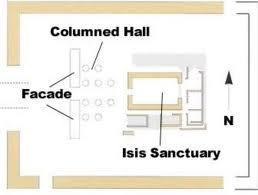
The main Isis temple at Isiopolis
Just north of Onuris’ temple lay the great temple of Isis at Isiopolis (I know, that’s the Greek name, but I just love the word; say it a few times and you might, too). Judging by the remains, the temple was built entirely of granite, which was rather unusual. Most of it was made of black granite, with some blocks of fine, red granite. The carvings are particularly beautiful, yet today, the entire site is in complete ruins…just a bunch of “stone blocks” littering the area. One of the blocks from this important Isis site has been found in Rome, apparently taken there to become part of the main Roman Isis temple.
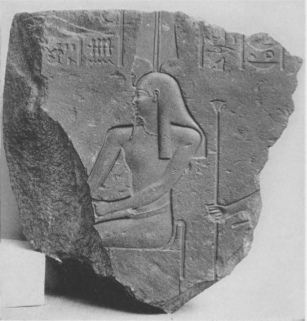
Osiris of Isiopolis, looking pretty spry
Isis was known as the Lady of Hebitet and Osiris as the Lord of Hebitet. But at Isiopolis, Osiris was not shown as the mummiform God. Rather, He was depicted as the renewed king, wearing the atef crown. Surely this is the magic Isis worked at Her temple in Isiopolis: nothing less than the renewal of Osiris. The roof of the temple seems to have had a number of shrines to various aspects of Osiris and would seem to have been a logical place for the festival pavilion of Isis mentioned earlier. Embalming often took place in special tents or pavilions and temple roofs often served in rites of renewal. Perhaps at Isiopolis they performed a combined rite of death and renewal that left Osiris young by virtue of Isis’ powerful magic and protected beneath Her beautiful wings.
Filed under: Goddess Isis Tagged: Behbeit el-Hagar, Deities, Goddess Isis, Iseum, Isis, Osiris, Rome, Sebennytos, Temple of Isis








September 16, 2013
So how esoteric is Isis, anyway?
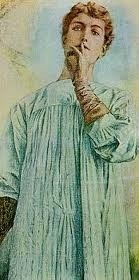
Shhhhh. “Silence” by Fernand Khnopff, 1890
I’ve just returned from the Esoteric Book Conference in Seattle. Seattle played itself quite nicely and came through with the requisite grey morning on Saturday and actual rain complete with thunder on Sunday. You could tell a lot of the crowd was local by the sighs of relief. There was even one dancer in the rain. And this is one of the many reasons why I love the Pacific Northwest.
Many thanks to conference organizers, Catamara Rosarium and William Kiesel and the whole EBC crew. They did a wonderful job of making the conference flow smoothly. Kudos also to Kate Merriwether-Lynch, who was volunteer coordinator and bookseller extraordinaire and Joshua Madara, who made sure the tech worked for everyone. And they both presented as well.
I went to every one of the presentations and enjoyed them all in different ways. In case you’re curious, here’s a link to the lineup. I met lots of wonderful, magical folks and enjoyed myself very much.
On Wednesday evening, I’ll be speaking with Karen Tate of the Voices of the Sacred Feminine podcast. Karen’s work is to bring Goddess to a wider, less esoteric audience.
Between the two appearances, I find myself pondering how esoteric Isis is? And how esoterically hidden or exoterically out of the closet do I want to be personally?

Esoteric Isis Veiled; weirdly, from the Herbert Hoover National Historic Site. It was a gift from Belgium for Hoover’s famine relief efforts in WWI. The Goddess is veiled as the Mystery of Life. She holds a triple flame of past-present-future and in Her other hand, a key of life. Seated, She is 7 ft. tall. If I’m ever in Iowa, I know where I’m going.
In the strict definition of esoteric—something that is understood or of interest only to a small group of people—yes, Isis is pretty esoteric. Those of you reading this blog are among the esoteric few. And it is certainly true that Isis has been vital to Western Esotericism from the beginning. Isis has served esotericism as the One Goddess Who is All Goddesses. Veiled, She has been the symbol of All Hidden Wisdom. She has been the Lady of Initiation and the Mother of Our Souls. (I trace all this in Isis Magic.)
On the other hand, most educated people, at least in the western world and I suspect much further, have at least heard of Isis. Whether via that old Isis TV show, a comic book, mythology study in school, or as a computer program, they’ve at least heard of Her. When I pay for something with a card with my name on it, clerks often ask me what my name means. When I explain it means “Gift of Isis,” they usually say something like, “Oh yeah, isn’t she that goddess who…?” So, exoteric?
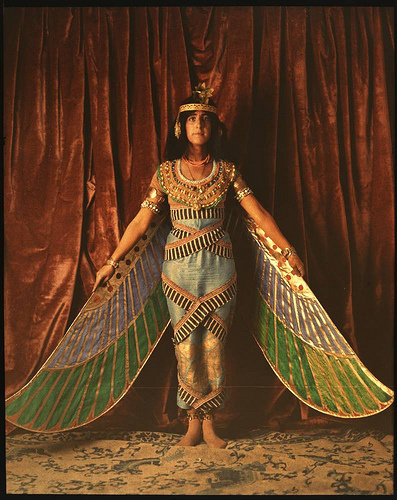
Exoteric Isis? I really put this image in just because she’s so awesome.
In terms of my own esotericism/exotericism, I never speak about my spirituality except among those who already know. I don’t wear occult jewelry at work. I don’t trade Christmas for Yule; if I want Yule off, I take a vacation day and consider Christmas a bonus. Those with alternative spiritualities can still suffer some serious discrimination and that’s just not my fight (though I greatly admire those whose fight it is). Of course, if you put my name in a search engine, you’ll pretty quickly find me as author of Pagan books. Nonetheless, small-group esoteric is working for me. At least so far.
I don’t really have any exciting conclusions here, but I’d be interested in knowing your thoughts. Are you exoteric or esoteric? Do you find that people generally know Who Isis is or not?
Filed under: Goddess Isis, Modern Paganism Tagged: Esoteric Book Conference, Goddess, Isis, Isis Magic, Religion and Spirituality








September 7, 2013
I love that Isis is a Trickster Goddess
Today, I’m getting ready for the Esoteric Book Conference at which I’ll be speaking next weekend, plus three or four or ten other things, so today I’m going to rerun this post on Isis as a Trickster. She is one of the few Trickster Goddesses and I kinda like that about Her…
Ah, the Trickster Deity. The one Who shakes things up, Who always has creative, boundary-crossing solutions to problems. The Trickster breaks the rules, makes us laugh, often embraces The Other by shapeshifting. The Trickster’s tricky ways can have unintended consequences; often unexpectedly positive, sometimes not so much. The Trickster is clever, of mind and of speech, talking us into doing things we might not normally do. The Trickster is also—usually—a male Deity.
There’s Hermes, Who stole Apollo’s cattle while still a toddler; and once Apollo got over Himself, He had to admit it was kinda funny and pretty cute. In Native American myth, we meet Coyote, Whose interference made human death permanent and Who is always angling to sleep with the women. In Welsh myth, there is Gwydion Who tricks His sister Arianrhod multiple times to get Her to accept Her son, Lleu. There’s the Spider God, Anansi of West African lore, Who trickily captured some of the most dangerous beings in all of Africa in order to win His powerful stories from the Creator. And, of course, there’s the troublemaker, Loki of Norse myth. He’s so tricky, on at least one occasion, He changes genders to get the job done.
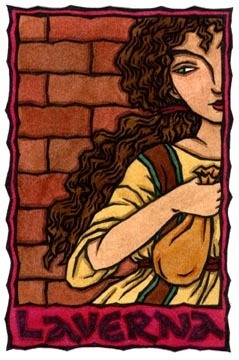
Artist Thalia Took’s rendition of Laverna
Trickster Goddesses are fewer and farther between. We have the Greek Eris with Her golden apple tossing, though generally, She’s more the Goddess of troublemaking and disharmony. The Roman Laverna is a true Tricksteress, Who tricked a number of people out of their property then got off on a technicality, thus becoming the Goddess of pickpockets and thieves. Yet these are fairly minor Goddesses. In fact, the only major Goddess I know of Who is a genuine Trickster is Isis.
We already know how Isis tricked the Sun God Re into revealing His True Name. But a lesser-known myth really shows Her Trickster stripes. Here’s the story as told in Isis Magic and which comes from the probably-New Kingdom Chester Beatty papyrus:
Finally, the day came when Horus was old enough to be taken before the Tribunal of the Gods and Goddesses to claim His father’s throne. Almost immediately, Shu the Lord of the Firmament said that Horus’ petition should be granted. Thoth wholeheartedly agreed and He brought out the Holy Eye of Re.
Isis was overjoyed. She called out to the North Wind, “Wind, blow! And carry the news to the Underworld and to Osiris, the father of our new king!”
But Neb-er-Djer, the Lord of the Utmost, was displeased and He grumbled about the quick decision. The Deities of the Ennead of Heliopolis all quickly put down His objections saying that it was useless to object since Horus had already taken the Royal Name and was wearing the White Crown of Osiris.
Now Set spoke up, “Since Horus has already taken what is not rightfully His, I ask that Ye Gods and Goddesses throw Him out to Me. Let Us see if He is worthy of His high office. Let Him fight with Me!”
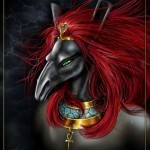
A modern rendition of fiery Set
A great argument now ensued. Thoth spoke for Horus. Re-Horankhti spoke for Set. All the Gods and Goddesses spoke for one or the other. And this contention between the two Gods continued in the Tribunal for 80 years, until all the Deities were tired and bored and cried out, “What can we do? How can we settle this?” But Wise Isis bided Her time.
It was decided that Thoth should write a letter to the Great Goddess Neith on behalf of the Tribunal. She, They believed, would know what to do. So Thoth wrote to Her—a beautiful letter full of praises for Neith and polite concern about the welfare of Her son, Sobek the Lord of Crocodiles. At the very end of the letter, Thoth finally asked what They all wanted to know: to Whom should the throne belong?
The Great Goddess straightaway gave answer to the Tribunal. “Give the throne to Osiris’ son, Horus,” She wrote, “and do not commit any injustice or I shall be angry and the sky will fall upon the earth.” Furthermore, Neith instructed the Deities that They should compensate Set by increasing His property two-fold and offering Him Anat and Astarte, the Goddesses of Phoenicia, as wives.
All the Gods declared that Neith was obviously right; all but Neb-er-Djer who started the whole argument over again. Soon the Deities were fighting once more, some agreeing with Horus, some with Set.
At this, Isis finally became furious. Her anger rose up. Then She Herself rose up, standing at Her full height as fury and flame emanated from Her Divine Form. In the names of Neith and of Ptah-Tanen, the Lord of the Earth, Isis swore a mighty oath. At the words of the Lady of Magic, the Gods were afraid and backed down, placating Her and agreeing that all She had said would be done and that Horus would receive His throne with no more ado.
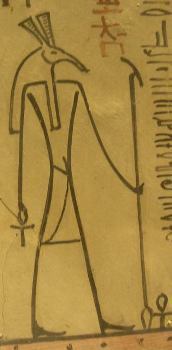
…and an ancient one
When Set heard this, it was His turn to be angry. He threatened to take His mighty scepter, which no one could wield but Himself, and kill one of the Deities each day. Further, He said He would no longer negotiate with the Tribunal as long as Isis was a member of it.
So Re-Horankhti secretly said to the Tribunal, “Come over to the island in the river. There We can make Our decision in peace for We shall tell Anti, the ferryman, not to ferry over any woman who even looks like Isis.” The Deities agreed and crossed over to the island where They sat down to eat a meal of barley bread.
Isis learned of Their plan, of course, and She uttered magic words of transformation. Instantly, Isis changed Herself into an old, bent woman, a crone mother. As Anti the ferryman sat on the shore by his boat, he saw what he believed to be an old woman approach him.
“Hail, ferryman,” said the old woman. “Take me across so that I may take this jar of flour to the boy who has been herding cattle there for the past five days. The poor boy will be very hungry by now.”
“No, old mother,” said Anti, “I have been instructed to take no woman across the river.”
The crone laughed, “Surely you were told not to take any woman who looks like Isis across the river. Do I look like Isis?”
Indeed, thought Anti, this old woman did not look like the beautiful Goddess Isis. “All right then. What will you give me to take you across, old mother?”
“I will give you this bread,” said Isis.
Anti laughed, “What is a loaf of bread to me? Do you think that I shall go against the order of the Gods for a loaf of bread?”
“Then I will give you this gold ring,” the disguised Goddess said as She took the ring from Her finger.
To this rich payment, Anti agreed, and he took Isis to the island.
When She arrived, She walked in and out of the trees until She saw the Tribunal eating bread with Neb-er-Djer. Set was there, too, and He caught sight of Her there in the trees, but He did not recognize Her because of the distance between them. Seeing that Set had noticed Her, Isis once more spoke magic words and transformed Herself into a maiden of unearthly beauty.
She moved into the open a little to let Set more clearly see Her beauty, then She turned and walked into the forest. Set’s heart instantly grabbed hold of Him. He could eat no more of the God’s pale bread. He could breath no more unless He could breathe the breath of this maiden. He left the Gods to search for her.
Hiding behind a tree, Set called out to the maiden, “Come to me, O beautiful one, O lovely girl. I am a God and I am waiting for you.”
Isis let Herself be seen fully now, glittering tears trembling upon Her blushing cheeks. She wept, “For me, Thou waitest in vain, Divine Lord. I was the wife of a cattle-keeper and I bore him a man-child. Then my husband died and our son became cattle-herd. But a stranger came and he threatened to beat my son and take his cattle and cast him out. I am distraught, my Lord! O what shall I do, my strong Lord?” The maiden looked up at the God hopefully, “Could it be that Thou wilt act as his deliverer?”
Set’s heart again spoke to Him—as did His loins when He imagined the young woman’s gratitude for His aid. Indignantly, He said, “What! Shall the cattle be given to a stranger when the good son of the farmer lives! This is an outrage! This stranger should be beaten and cast out and the son should be set in his father’s place.”
In an instant—before Set could tell what was happening—the beautiful young woman transformed Herself into the Kite of Isis and flew like the wind to the top of the tree.
“HA!” She screeched in Her kite’s voice. “Now it is Thou who shouldst weep, My Lord! Thine own mouth hath condemned Thee. Thou hast passed judgment upon Thyself. There is nothing Thou canst do to prevent it!”
Then Set knew Who the Kite really was. He knew He was ruined. He burst out in angry weeping and ran to His ally, Re-Horankhti, and related the whole tale. But Re-Horankhti agreed with Isis. “Verily, Thou hast passed judgment upon Thyself, even as She said.”
In His rage, Set had the unfortunate ferryman strung up and beaten upon the soles of his feet until he no longer had any soles.
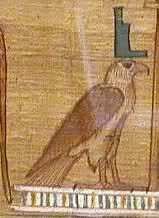
Isis transforms into Her sacred raptor, the Kite
In this story, we see Isis in full shapeshifting Trickster Mode. Isis tricks the unfortunate, yet greedy, ferryman with Her innocent old lady routine. She tricks Set as a blushing young widow, seducing Him to Her side. In this single story, Isis shows Herself as All Goddess, appearing as Maiden (the young widow), Mother (defending Her son in the Tribunal), and Crone (the old woman), as well as in the form of Her sacred bird, the kite.
Yet Isis’ trickery is in service to Mâet, what is Right. She ensures Horus inherits what is rightfully His. She ensures Set does not. And She teaches that, contrary to the 80s mantra, greed is, in fact, not good.
Even this does not exhaust the Egyptian myths in which Isis appears as a Trickster. But this post is long enough, so we’ll leave other tales to other times…
Filed under: Goddess Isis, Modern Paganism Tagged: Goddess, Goddess Isis, Horus, Isis, Isis Magic, Isis the Trickster, Trickster








August 31, 2013
Isis the Lighthouse Goddess

This scene is from a Roman tomb; some think it may be a scene from the Navigium Isidis, though I see no ship…
As one of the ancient seaport of Alexandria’s key Goddesses, Isis was closely associated with the sea. She is called Isis Pelagia, “Isis of the Sea,” specifically. The famous festival of the launching of the ship of Isis, the Navigium Isidis, marked the opening of the shipping season on the Mediterranean Sea.
But there is another epithet of Isis that connects Her with the sea, shipping, sailing, and the wind necessary for it. It is Pharia. As Pharia, Isis is connected with the great lighthouse of Alexandria, one of the Seven Wonders of the Ancient World and a famous symbol of the city of Alexandria. The lighthouse was called the Pharos after the small island on which it stood. Due to the lighthouse’s fame, pharos eventually became a general term for “lighthouse.” (This persists even in modern languages; in Italian and Spanish, lighthouse is faro and in French, it is phare.)
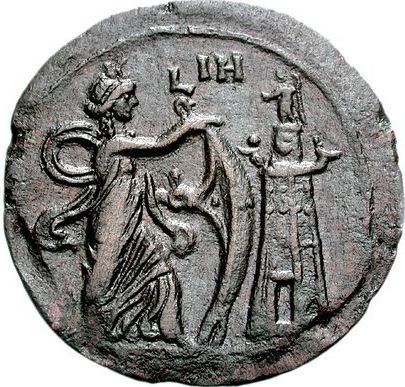
Isis Pharia with Her sail and the lighthouse on the right on an Alexandrian coin
Isis Pharia is Isis the Lighthouse Goddess. Alexandrian coins frequently represented the Goddess and the Pharos together. Roman inscriptions attest to the existence of an Isis temple or shrine on the island, very close to the lighthouse itself. Between 1994 and 1998, archeological divers in the bay of Alexandria discovered a huge, red-granite torso of a woman, the base of an Isis statue, pieces of the Pharos itself, as well as the remains of a rock-cut temple that may very well be part of the temple of Isis Pharia.
There are several legends about how the Pharos island got its name. One says that when Menelaus was returning from the Trojan War, his ship was blown off course and landed on the island. Not knowing where he was, he asked the first Egyptian he saw. The man responded, “Per Aoh,” meaning that the island belonged to the pharaoh. (Pharaoh is the Greek corruption of an Egyptian term for king, Per Aoh, which means “Great House.”) Menelaus heard it as “pharos.”

An artist’s vision of the Pharos lighthouse of Alexandria
Another story derives the name from that of Menelaus’ helmsman, Phrontis, who died on the island. In Greek, the word pharos refers to a cloth or sail. In accordance with this punning meaning, images of Isis Pharia show Her with a billowing sail in one hand while Her cloak is blown backwards over Her shoulder and the famous lighthouse stands in the background.
In late legend, Isis was said to have invented the sail while searching for Her son, Horus. The early Christian writer Tertullian, writing against the Pagan religions, says that Pharia’s name “shows her to have been the king’s daughter,” (as opposed to being a true Goddess, of course). Tertullian is surely interpreting Pharia as a feminized version of pharaoh.
Just as the illumination of the Pharos lighthouse turned Alexandria’s dangerous seas and tricky harbors into commerce-friendly ports, the spiritual light of the Lighthouse Goddess served as a guide for humankind. Isis Pharia is the guardian of navigation and safe harbors—of ships and of souls.
Filed under: Goddess Isis








August 24, 2013
Isis & D.H. Lawrence
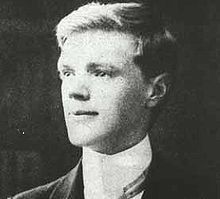
D.H. Lawrence, 1906
I’ve been catching up on my reading on modern Paganism lately and have been working on Ronald Hutton’s masterful Triumph of the Moon, a History of Modern Pagan Witchcraft. In one chapter, Hutton refers to a short story by D. H. Lawrence in which “The Man Who Died” survives His crucifixion, meets a devout Priestess of Isis, honors her Goddess, and makes love to her as her Osiris.
Wait…what!? D.H. Lawrence, author of Lady Chatterly’s Lover and other well-known erotica, wrote a story about Isis and Her priestess?
Turns out, yep. He did. Is it erotic ala Lady Chatterly? Turns out, yep, it is. In fact, it gives a whole new meaning to the phrase, “He is risen!” I am not kidding. It must have caused more than one vicar’s head to explode when it first came out in 1929, a year before Lawrence’s death.
Here is Lawrence’s own summary of the story in a letter to a friend of his:
I wrote a story of the Resurrection, where Jesus gets up and feels very sick ’bout everything, and can’t stand the old crowd any more—so cuts out—and as he heals up, be begins to find what an astonishing place the phenomenal world is, far more marvelous than any salvation or heaven—and thanks his stars he needn’t have a mission any more.
But as you already know from the introduction to this post, dear Isiacs, that is just the beginning of the story. So I shall tell you the rest:
After some healing up at the home of some peasants, Jesus has an encounter with the Magdelene (whom Lawrence calls Madeleine) that sorely disappoints her as Jesus will not return to the disciples with her. Leaving, Jesus wanders to the sea at Lebanon.
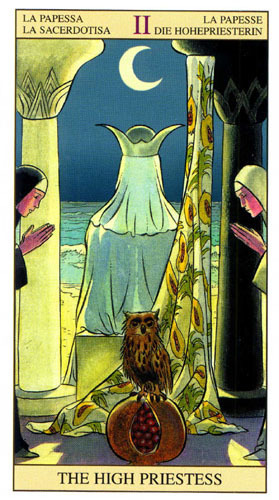
A very interesting rendition of the High Priestess card, or The Papess
At the sea’s edge, He comes upon a small Temple of Isis, built to face towards Egypt. It had been built by a 27-year-old priestess of Isis, who had tended it for the past seven years. She serves “Isis Bereaved, Isis of the Search.” Lawrence describes the statue of the Goddess beautifully, but the description doesn’t match any images I know of, except perhaps the Isis Pelagia on Alexandrian coins. The priestess has quietly serving her Goddess, waiting.
Jesus and the priestess meet. He asks for shelter saying, “The Goddess is great.” The priestess gives Him shelter. The slaves of the priestess spot the marks on His hands and feet and declare Him a “malefactor.” Days pass as the pair comes to know each other. Jesus is numb to the world and has no interest in women. The priestess, too, has no interest in men.
But, of course, things change.
The priestess invites Jesus to the temple with her to see the Goddess. He goes. Eventually, she believes Him to be Osiris:
“Great is Isis!” he said. “In her search she is greater than death. Wonderful is such walking in a woman, wonderful the goal. All men praise thee, Isis, thou greater than the mother unto man.”
The woman of Isis heard, and threw incense on the brazier. Then she looked at the man.
“Is it well with thee here?” she asked him. “Has Isis brought thee home to herself?”
It is important to remember that Jesus could not be touched during all this time; His experiences made it just too much. Eventually, though, He allows Himself to be touched and healed as Osiris through the priestess and the Goddess Herself. They make love in the temple before the Goddess. He never asks the priestess’ name; she never asks His, but knows Him to be Osiris.
Time passes. The priestess conceives.
But just as Osiris leaves Isis in His death, so Jesus must leave the pregnant priestess. Slaves have recognized Him and the Roman authorities are on the way. Jesus makes His escape.
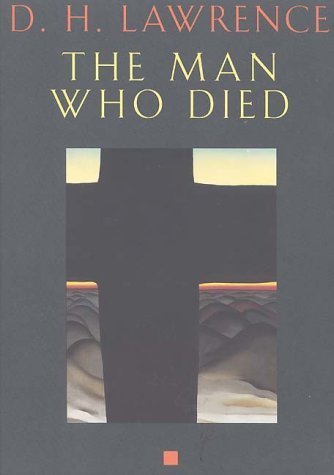 If you wish to read the whole story—and it is worth doing—you’ll find it here.
If you wish to read the whole story—and it is worth doing—you’ll find it here.
I thought this was pretty cool. I was prepared to be disappointed by the story itself, but in general, I wasn’t. The writing is moody, only gently steamy.
According to Hutton, the story is fully of its day; a time when, in England at least, many people were trying to reconcile Christianity with their ideas about (little p) paganism and finding much good in doing so. The equation of Jesus-Osiris was well known in alternative religion circles of the period. And it is from that time that the equation most recently comes into our modern understanding.
Still, they didn’t make it up then. The connection was definitely being made at the time Jesus is supposed to have lived. In Coptic magical papyri, Egyptian and Jewish Deities are invoked together for help. I’m checking the magical papyri now to see if I can find a direct Jesus-Osiris equation, but there definitely is an Osiris to Dionysos, Dionysos to Jesus historical equation. For more on Jesus and Osiris, have a look at this earlier Isiopolis post on the subject.
At any rate, the Lawrence story is one more link in modern Isiac tradition and I’m very pleased that Mr. Hutton helped me to discover it. I hope you will enjoy it, too.
Filed under: Goddess Isis, Modern Paganism Tagged: D.H. Lawrence, Egypt, Goddess, Isis, Jesus, Osiris, Ronald Hutton, Temple of Isis








August 18, 2013
Idolatry, yes!
Yeah, I know. I went for the “SEX! now that I have your attention” headline. Sorry.
But this is a topic many of us still have to contend with when it comes to explaining those images on our altars to some members of the major monotheisms. Especially if you have a rather—ahem—extensive shrine like I do.
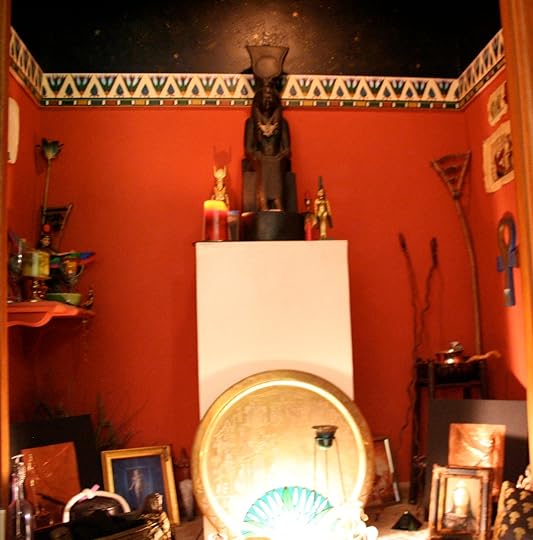
My sacred image-filled Isis shrine. We sacrificed a double closet to give Her this space.
If you’ve ever found yourself in that situation, you probably ended up saying sometime like, “I don’t worship the statue. I worship the Deity represented by the statue.” It seems so simple and obvious. And it is. For the most part.

My other enlivened Isis image; She was one of my first
But when it comes to ancient Egyptian tradition, things do get a bit more interesting. As you probably already know, images were extremely important in Egyptian tradition. Images, and most especially the sacred images of the Deities, could become vessels for the indwelling of the Divine presence. Once the proper rites were performed, the Deity was, in some sense, alive within the image and became a fit representation of that Deity to the worshipper. The sacred image provided a way for the Deity to be physically present in the material world. Jeremy Nadler, one of my favorite writers on the subject, says in his Temple of the Cosmos, “The gods could not be distinguished from their statues or images, and to have done so would have been as false to the ancients as it would be questionable for us moderns to distinguish between a person and his or her body.”
And the Egyptians weren’t the only ones. In Apuleius’ tale of initiation into the Mysteries of Isis, he tells us that he repeatedly stood before the temple statue of the Goddess and worshipped Isis in Her image. “I was wrapt in my gaze on the image of the Goddess,” he writes. Later in the story, he describes a deeply emotional experience he has had while praying before the statue. “I laid myself down at last in obeisance before the Goddess and for a long time wiped Her feet with my face. Then, with welling tears, breaking my speech with frequent sobs and swallowing my words, I addressed Her.” In describing an earlier procession of the Goddess, Lucius mentions the images carried by special bearers and which he calls “breathing effigies.” Very much in the Egyptian tradition.
The idea that a Divine spark can become attracted to and activated in a special image passed into Renaissance Europe via the Hermetic tradition; a tradition deeply rooted in Egyptian as well as Greek philosophy. The Qabalistic tradition has handed down the idea of the golem, a being made from clay that the Rabbis activated by prayer and ritual. In alchemy, the homunculus, or “little man,” is a similar concept. The idea that certain images can be enlivened or charged by the Divine comes into modern magical religions as talismanic magic in which special symbols and images (talismans) can be consecrated with Divine energy. The word talisman comes from the Greek for a perfect or completed object; thus it would be quite reasonable to think of your sacred images as talismans.
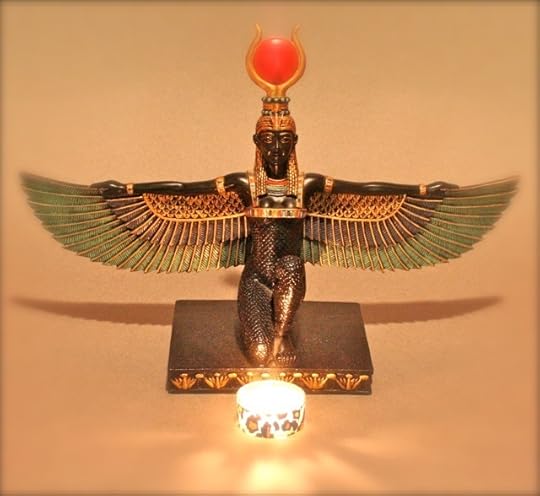
Another favorite, but this one hasn’t been enlivened. Yet, anyway.
Some cultures believe that God, the Deities, or the Divine Spirit is contained within all things. These animistic, pantheistic, or panentheistic cultures understand the world as brilliantly alive and sacred. On this subject, the Greek philosopher Plotinus wrote, “there is nothing which is without a share of soul.” Iamblichus, a Neoplatonist philosopher, joined him in finding the world alive, ensouled, and sacred declaring, “as to the first principle, that the gods dwell only in heaven, it is not true. Everything is full of them.” Many indigenous cultures, too, share this view, as do many modern Neo-Pagans, Polytheists, Wiccans, Goddess devotees, and more. If we accept this, then even the materials with which our sacred images are constructed contain a bit of the Divine within. And they will only be more powerful when specifically activated to receive an influx of the Divine.
The large image of Isis that sits upon my altar as well as the small golden one to the left and behind the candle have both been enlivened through ritual and invocation. (Isis Magic includes a ritual for enlivening your own sacred image in the Magician chapter, if you are so inclined.) As living images they serve as a focus for my meditation and prayer. Having a special image like this does not mean that we worship the image. Instead, we honor that spark from the heart of the Goddess that resides within the image—as within All Things. The image is a focus for our prayers and a conduit for the blessing of the Goddess. The spark within it lights the fire of our love for the Great Goddess Isis—Whose true image is everywhere and nowhere.

My large, enlivened Isis in Her outdoor temple
Filed under: Goddess Isis








August 10, 2013
(Almost) Modern Priestesses & Priests of Isis
We often talk about Isis and Her priestesses and priests in ancient days, but today, I’d like to go a bit more modern. It’s important because those of us who are attracted to Isis today have a modern Isis heritage, too. Exploring that heritage helps us understand why Isis continued and continues to be a potent presence in much of society even today.
Isis today lends Her name to a variety of medical, scientific, and technology companies, an institute working for international peace, a superheroine who rights wrongs, and parent-training classes. And this list by no means exhausts the subject.
All these organizations chose to use Her name for a reason—besides the awesome acronym-creating symmetry of I-S-I-S. Their choice surely has to do with the well known ancient character of the Goddess. (Except for the folks responsible for the Isis mobile payment system. Know what they or their PR folks did? They actually went in and edited the Isis Wikipedia article to make Her “the goddess of simplicity” and used that false definition in their press releases to justify use of Her name for their “simple” mobile payment system. Luckily, that bullshit has since been removed. Sheesh.)
But I digress.
Part of the reason Isis continues to be known generally is that there have always been those who knew Her not only from Her myth, but more personally: as the Goddess She is. Today, I’d like to introduce you to a few of them from the last two centuries.
Anna Kingsford
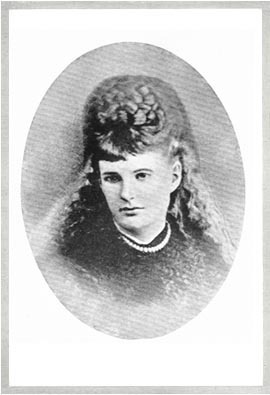
Anna Kingsford
Born in 1846, Kingsford was one of the first women in Britain to become a medical doctor, edited a feminist newspaper, and served as president of the Theosophical Society. She was a vegetarian, an anti-vivisectionist, and an opponent of fox hunting. She is considered one of the inspirations for the Golden Dawn, a school of Hermetic magic that has been was one of the sources of modern neo-paganism. The equality of the sexes in the Golden Dawn is acknowledged as her contribution.
Kingsford’s theology might be called Gnostic Christian Polytheist…and I might add Goddess for, to the feminist Kingsford, the Mother of God, Sophia, and Isis were all quite present and Kingsford even posited a new and female savior.
In Kingsford’s visions, Isis appears as the mother of Jesus, or rather, Jesus appears as Her son. Just as in the early days of Christianity, Isis and the Virgin Mary are identified. Isis also shows up as the Goddess of Initiation, as the Angel of the Moon, and as Nature Herself. She was also the Goddess who could represent the Higher Genius (Higher Divine Self; Holy Guardian Angel; Augoides), serving as a Divine Mother of the human being. This is one of the things Isis has indeed done for me personally.
Moina & MacGregor Mathers
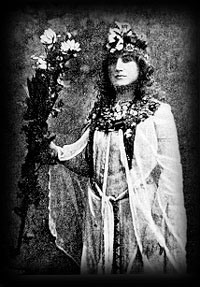
Moina Mathers dressed in her priestess of Isis garb
If Isis was present in the theosophy of Anna Kingsford, She is even more so in the work of the magicians of the Golden Dawn, especially Moina and MacGregor Mathers. He was one of the founders, she was a leading adept and ran the order after his death.
Established in 1888, the Golden Dawn is one of the most important esoteric groups of the modern age. Its influence on modern theurgic groups has been immense. Many modern spiritual groups, from Rosicrucians to Neo-Pagans, continue to work the rituals and exercises originally created by the magicians of the Golden Dawn. In a book published less than a decade ago, Doreen Valiente, a leader of the Wicca revival, cited the Golden Dawn material as the best way for Wiccans to learn and understand magical technique.
Goddess is an essential and equal aspect of the Golden Dawn’s understanding of the Divine. In the Golden Dawn, the Goddess goes by many names, but one of the most prominent is Isis.
MacGregor and Moina had a very deep personal interest in Isis. Through their Isis Movement, which they promulgated in Paris at the turn of the 20th century, they hoped to do no less than revive the worship of the Goddess. To this end, they performed what they called the Rites of Isis, at first privately and eventually publicly.
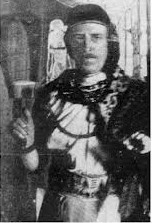
MacGregor Mathers dressed in his priest of Isis garb
MacGregor stated that he and Moina had become Isis converts due to their “re-discovery of lost truths.” They also claimed to worship Isis in a “pure and primitive form.” And they stated that they believed that the revival of the Isis religion would be a great force for good in the world.
Dion Fortune
Dion Fortune, born in 1890, was a prominent British occultist, author, psychologist, teacher, artist, mystic…and priestess of Isis.
The special focus of Dion Fortune’s magical work with Isis had to do with the moon cycles as reflected in women and which she believed offered healing to men. She taught that women and men must awaken to the natural magic of the cycles which are an integral part of our lives; that we must open ourselves to the flux and reflux power of the Moon Goddess in order to bring balance and spiritual healing to our souls and to our lives.
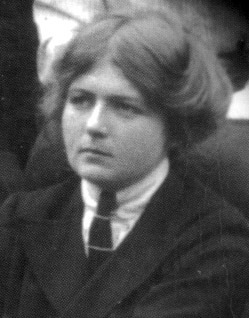
Dion Fortune in her school girl days
To Dion, the Great Goddess Isis is both the source and the Divine teacher of this esoteric knowledge of balance. She is the universal Divine Feminine and She is the Goddess of the Moon, which was at the time THE essential symbol of femaleness.
Dion Fortune’s books, The Sea Priestess and Moon Magic, are about the awakening of a man to Isis via Her priestess, Dion’s alter ego, the priestess Vivian LeFay Morgan (yeah, I know…). But these novels are arguably the best—and perhaps the only—novels about real magic ever. Other novels fantasize the magic. Dion doesn’t. She simply tells you what she is perceiving on the astral. What’s more, she intended the reading of the novels to be a sort of initiation to Isis. And so they have been for more than a few priestesses of Isis that I know.
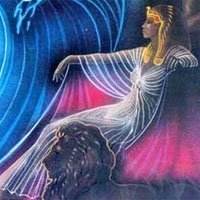
Cover art for Fortune’s The Sea Priestess, 1981 edition
Dion Fortune was extremely influential and deeply involved in the occultism of her day. She continues to have influence even today for the Society of the Inner Light (founded as the Community of the Inner Light) that she founded continues to teach students to this day. A modern day Mystery school, the Servants of the Light, continues Dion’s legacy, having developed from the Society of the Inner Light.
Her biographer, Alan Richardson, opines that, “she was never more true to herself or more potent on magical levels, or more influential within the world, than when she assumed the qualities of the Great Goddess herself, when she became priestess of Isis.” (Alan Richardson, Priestess: the Life and Magic of Dion Fortune)
Just as we who love Isis today are heirs of an ancient tradition with its roots in Egypt, so we are part of a continuing line of priestesses and priests, including some who are much closer to us in time than the priestesses and priests of 1500 BCE. Perhaps someday our own daughters, sons, and students will be among those who carry Her name and magic into the future as well.
Filed under: Goddess Isis Tagged: Anna Kingsford, Dion Fortune, Doreen Valiente, Goddess, Goddess Isis, Golden Dawn, Isis, Isis Magic, Moina Mathers, Moon Goddess, Moon Magic, priestess of Isis








August 3, 2013
Isis & the Sorcerer’s Apprentice
I’m working on my talk for the Esoteric Book Conference in September. It will be on Isis as Goddess of Magic and especially on how She interacts with Her sacred magicians.
One of the magician stories I’ll tell has been one of my absolute favorites ever since I learned Isis was part of the story and I’d like to share it here with you today.
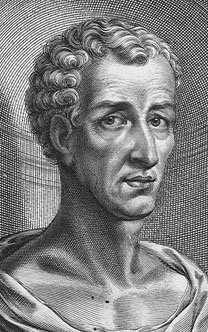
Lucian, a fictional portrait courtesy of Wikipedia
In the first century CE, there was a Syrian writer, who wrote in Greek, named Lucian. He wrote satirical novels, tales, and essays. One of his books is called Philosudes (“Lover of Lies”). It’s about a group of friends gathered at the house of an ill friend, Eukrates. To entertain him, they tell fantastic stories about haunted houses, encounters with Deities, magic, and more, which Eukrates, being a lover of lies, enjoys very much.
The tale that involves Isis is told by Eukrates himself and he swears it’s all true:
He says that in his youth, his father had sent him to Egypt to complete his education. He sailed up to Koptos with the intention of going to the statue of Memnon for an oracle. On the way there, he met a man from Memphis who was one of the temple scribes and very learned. How did Pankrates—for that was the scribe’s name—come by his knowledge? He had spent 23 years living “underground” in Egyptian sanctuaries learning his magic from Isis Herself. Ha!
Pankrates was apparently quite a famous teacher and another of Eukrates’ friends had been a student of his as well. The magician-scribe was supposed to be able to do wonders such as riding on crocodiles and playing with dangerous beasts without harm. (Taming crocodiles is a common Egyptian magical wonder.)
[image error]
Isis the Magician working Her heka; art by Bill Bounard, “Open Your Heart”
Meanwhile, back to Eukrates. Apparently he and the magician hit it off and Pankrates invited the young man to visit his home and began teaching him. However, Eukrates was to leave all his servants in Memphis for they would not be needed in the magician’s home.
Which turned out to be true.
Whenever a household task needed doing, Pankrates would take up a stick of wood, a broom, the door bar, or a pestle, clothe it, speak some words of magic, and the broom would come to life and take care of whatever task the magician wanted. When the task was done, Pankrates would speak more magic words and the magical servant would return to its original form.
Pankrates taught Eukrates many things, but he wouldn’t teach this. Naturally, that was exactly what Eukrates wanted to learn, so he spied on the magician and overheard the words that brought the servant to life. The next day, when the magician went out, Eukrates tried out what he had learned. He took a broom, dressed it, and spoke the words.
Instantly, the servant came to life and Eukrates ordered it to fetch water. Which it did. And kept on doing until there was water, water, everywhere. Eukrates ordered it to stop, but it wouldn’t for he hadn’t learned quite as much as he’d thought. So Eukrates tried force, breaking the broom in two…and now two servants brought water until the house was practically floating. Finally Pankrates returned home and restored order. Then he left, and Eukrates never saw him again.

Eukrates looking like Mickey
Does this tale ring a bell? Perhaps you are imagining Eukrates with mouse ears?
Yep. This is the story that inspired Walt Disney’s The Sorcerer’s Apprentice in the movies Fantasia and Fantasia 2000. Disney, of course, missed the important fact (to me, anyway) that the magician was trained by the Great Goddess of Magic Herself as well as the Egyptian setting.
That’s because the story came to Disney by way of the German writer Johann Wolfgang Geothe (1749-1832), author of Faust and Der Zauberlehrling (“The Sorcerer’s Apprentice”). Goethe did indeed get his tale from Lucian, but he left out the Egyptian connection. His poem became famous throughout Europe and inspired French composer Paul Dukas (1865-1935) to create his scherzo, L’apprenti sorcie, which Disney used for the soundtrack.
I would SO love to see someone do this story in its original Egyptian context—complete with the backstory of Pankrates’ training with Isis!
Filed under: Goddess Isis Tagged: Disney, Fantasia, Goddess Isis, Isis, Isis Magic, Isis the Magician, Lucian, Sorcerer's Apprentice











